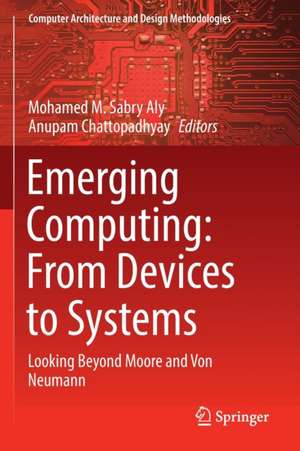Emerging Computing: From Devices to Systems: Looking Beyond Moore and Von Neumann: Computer Architecture and Design Methodologies
Editat de Mohamed M. Sabry Aly, Anupam Chattopadhyayen Limba Engleză Paperback – 14 iul 2023
Chapters "Innovative Memory Architectures Using Functionality Enhanced Devices" and "Intelligent Edge Biomedical Sensors in the Internet of Things (IoT) Era" are available open access under a Creative Commons Attribution 4.0 International License via link.springer.com.
| Toate formatele și edițiile | Preț | Express |
|---|---|---|
| Paperback (1) | 650.80 lei 43-57 zile | |
| Springer Nature Singapore – 14 iul 2023 | 650.80 lei 43-57 zile | |
| Hardback (1) | 905.36 lei 43-57 zile | |
| Springer Nature Singapore – 13 iul 2022 | 905.36 lei 43-57 zile |
Preț: 650.80 lei
Preț vechi: 765.65 lei
-15% Nou
Puncte Express: 976
Preț estimativ în valută:
124.53€ • 130.35$ • 103.65£
124.53€ • 130.35$ • 103.65£
Carte tipărită la comandă
Livrare economică 31 martie-14 aprilie
Preluare comenzi: 021 569.72.76
Specificații
ISBN-13: 9789811674891
ISBN-10: 9811674892
Ilustrații: VI, 456 p. 190 illus., 157 illus. in color.
Dimensiuni: 155 x 235 mm
Greutate: 0.71 kg
Ediția:1st ed. 2023
Editura: Springer Nature Singapore
Colecția Springer
Seria Computer Architecture and Design Methodologies
Locul publicării:Singapore, Singapore
ISBN-10: 9811674892
Ilustrații: VI, 456 p. 190 illus., 157 illus. in color.
Dimensiuni: 155 x 235 mm
Greutate: 0.71 kg
Ediția:1st ed. 2023
Editura: Springer Nature Singapore
Colecția Springer
Seria Computer Architecture and Design Methodologies
Locul publicării:Singapore, Singapore
Cuprins
Section I: Background.- Chapter 1: Introduction.- Chapter 2: Recent Trends in Computing Architectures.- Section II: Devices and Models.- Chapter 3: Logic Devices (Ambipolar, CNFET, NCFETs).- Chapter 4: Memory Devices (TIGFET, ReRAM).- Chapter 5: Interconnect and integration (Photonics, monolithic 3D, on-chip wireless).- Chapter 6: Computing with nano-Magnetic Logic.- Chapter 7: Quantum Technologies.- Section III: Circuits and Architectures.- Chapter 8: Near-memory Computing.- Chapter 9: In-Memory Computing.- Chapter 10: Brain-inspired Computing (Neuromorphic Computing, Hyperdimensional computing).- Chapter 11: On-Chip Communication Architectures (Scaling issues, Wired, Wireless, Photonic NoC).- Section IV: Design Automation Flows.- Chapter 12: Synthesis and Technology Mapping for Emerging Technologies.- Chapter 13: Verification and Testing for Emerging Technologies.- Chapter 14: Error-Tolerant Mapping for Quantum Computing.
Notă biografică
Mohamed M. Sabry Aly is an Assistant Professor at Nanyang Technological University, Singapore, and the founder of EMASS. He received his Ph.D. degree in electrical and computer engineering from École Polytechnique Fédérale de Lausanne (EPFL), in 2013. He was a postdoctoral research fellow at Stanford University from 2014 till 2017. His current research interests include system-level design and optimization of computing systems enabled by emerging technologies, with particular emphasis on computing systems for artificial intelligence. He is a currently the program manager of the Singapore flagship AME programmatic project (Hardware Software Co-optimization for Deep Learning). He is an active close collaborator with top industrial and academic partners such as, Stanford University and TSMC. Prof. Aly is a Senior IEEE member and he was the recipient of the Swiss National Science Foundation Early Post-Doctoral Mobility Fellowship in 2013.
Anupam Chattopadhyay is an Associate Professor in the School of Computer Science and Engineering, Nanyang Technological University, Singapore. He received his B.E. degree from Jadavpur University, India in 2000. He received his MSc. from ALaRI, Switzerland and PhD from RWTH Aachen in 2002 and 2008 respectively. From 2008 to 2009, he worked as a Member of Consulting Staff in CoWare R&D, Noida, India. From 2010 to 2014, he led the MPSoC Architectures Research Group in RWTH Aachen, Germany as a Junior Professor. During his PhD, he worked on automatic RTL generation from the architecture description language LISA, which was commercialized later by a leading EDA vendor. Together with his doctoral students, he proposed new research directions in high-level synthesis, application-specific processors and emerging technologies. In these areas, he published as a (co)-author over 150 conference/ journal papers, several book-chapters and books. He is a senior member of ACM, senior member ofIEEE and fellow of Intercontinental Academia.
Textul de pe ultima copertă
The book covers a range of topics dealing with emerging computing technologies which are being developed in response to challenges faced due to scaling CMOS technologies. It provides a sneak peek into the capabilities unleashed by these technologies across the complete system stack, with contributions by experts discussing device technology, circuit, architecture and design automation flows. Presenting a gradual progression of the individual sub-domains and the open research and adoption challenges, this book will be of interest to industry and academic researchers, technocrats and policymakers.
Chapters "Innovative Memory Architectures Using Functionality Enhanced Devices" and "Intelligent Edge Biomedical Sensors in the Internet of Things (IoT) Era" are available open access under a Creative Commons Attribution 4.0 International License via link.springer.com.
Caracteristici
Provides a detailed treatment of the complete range of emerging computing technologies Highlights the key advances and research challenges Methodically covers the entire system stack – from devices to architectures














